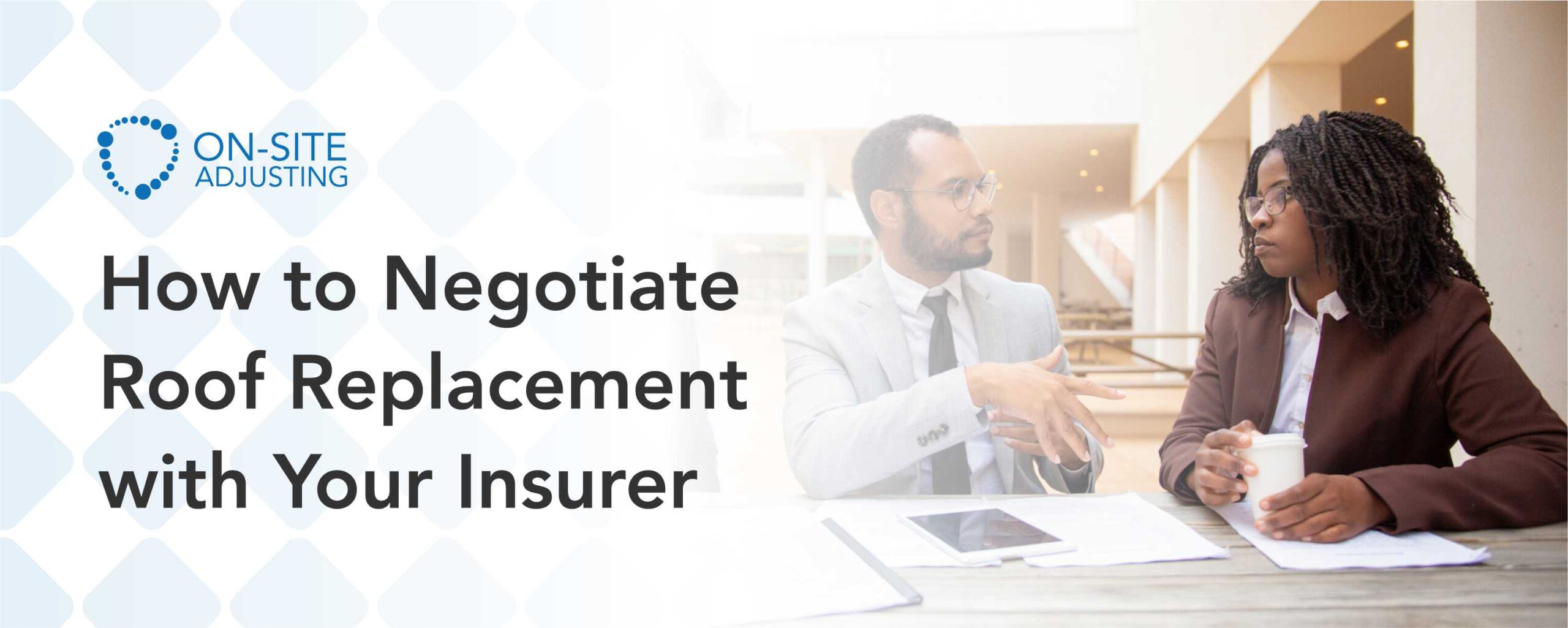
Many homeowners pay their premiums promptly to ensure that the financial cost of repairing their home after suffering damage is covered. However, it does not always happen that way in practice. This especially applies to roof replacement. Your insurance may cover only specific parts of your roof rather than repairing the whole thing. Therefore, you will need to negotiate with them. However, it is best to hire a public adjuster to handle negotiations on your behalf as they are faster and reliable.
Negotiating a roof replacement with your insurer can be challenging. However, we will help you understand the situations when insurance will refuse to cover a roof replacement. We will also explain when you can negotiate. This knowledge will make the process significantly easier for you.
What Are The Types of Roof Damage Coverage?

Homeowners’ insurance typically covers different types of roof damage under specific circumstances. They include:
Wind and Hail Damage
Most standard homeowners insurance policies cover damage due to wind and hail. This includes high winds blowing shingles off or hailstones breaking shingles. Sometimes, strong winds can lift the shingles and cause water to infiltrate the underlayment. This can cause even more damage. Hail damage often results in dents or punctures, therefore compromising the roof’s integrity.
Fire Damage
Standard policies typically cover fire damage. This includes damage due to wildfires, lightning strikes, or electrical fires. This also includes smoke damage, which can affect the structural integrity and appearance of the roof. Insurers usually cover the roof replacement costs and any associated structural repairs necessary due to fire damage.
Falling Objects
Policies usually cover damage from falling objects, such as tree branches or debris from storms. Falling objects also include man-made objects like satellite dishes or antennas. The impact of these objects can cause significant structural damage. This usually requires extensive repairs or replacement.
Vandalism
If someone vandalizes your roof and damages it, your insurance policy will likely cover the repairs or replacement. Some examples of acts of vandalism are deliberate damage to shingles, tiles, or other roofing materials. Insurers typically cover these events because they are unforeseen and beyond the homeowner’s control.
Water Damage
Water damage coverage can vary. However, some policies cover damage from water infiltration due to roof issues, especially if it results from a covered event like a storm. This can also include coverage for water damage to the interior of the home caused by leaks in the roof. Insurers often require proof that the damage was sudden and accidental, not due to long-term neglect.
When Can You Negotiate A Roof Replacement?
You should consider negotiating with your insurer in the following instances:
Discrepancies in Damage Assessment
There may be a significant difference between the insurance adjuster’s damage assessment and your contractor’s own. In that case, you can negotiate for a higher payout. This is because insurance adjusters often miss certain damages. Also, they may undervalue the extent of needed repairs. Therefore, when you request a higher payout, you increase your chances of getting a roof replacement.
Partial Coverage
If the insurance company offers only partial coverage that does not meet the repair costs, you can negotiate for a full replacement. This often happens when the insurer deems some damage as pre-existing or due to wear and tear. If you can prove that the covered event caused the damage rather than wear or tear, you may be able to get a roof replacement.
Policy Misinterpretation
If you believe the insurer has misinterpreted the terms of your policy, you can also negotiate. Sometimes insurers may overlook certain clauses that favor the policyholder, such as coverage for wind or hail damage. Present parts of your policy that support your request for a roof replacement.
Depreciation Disputes
Insurance companies often apply depreciation to your roof based on its age and condition. If you feel the depreciation is excessive, you can negotiate for a better valuation. Therefore, you can convince the insurer to replace your roof.
How to Effectively Negotiate A Roof Replacement
 Negotiating with your insurer requires preparation, documentation, and persistence. Here are the steps to follow:
Negotiating with your insurer requires preparation, documentation, and persistence. Here are the steps to follow:
Gather Evidence
Collect as much evidence as possible to support your claim. This should include detailed photos and videos documenting the damage from various angles. When taking photos or videos, ensure you capture the extent of the damage clearly. This will help highlight any areas of damage that may not be immediately obvious.
If possible, you should also provide records of any repairs or maintenance previously done on the roof. This helps establish that you maintained your roof well. Most importantly, it shows that the covered event caused the damage.
A detailed report from a licensed roofing contractor outlining the damage and estimated repair costs can also help your case. The report should include a thorough assessment and a breakdown of the necessary repairs or replacements.
Understand Your Policy
Thoroughly review your insurance policy to understand what is covered and what is excluded. Pay attention to terms related to roof damage, depreciation, and exclusions. Understanding your policy’s fine print can provide leverage during negotiations. It will also help you recognize when an insurance adjuster is trying to purposely misinterpret your policy.
Get Multiple Estimates
You should get estimates from different reputable roofing contractors. Having several estimates can provide a stronger case when negotiating with your insurer. These estimates should be detailed, including the cost of materials, labor, and any additional expenses.
Prepare a Detailed Claim
When submitting your claim, include all the evidence. The evidence should not just have photos and videos but also your contractor’s estimate and report. You should also include a clear explanation of why you believe the insurer’s initial assessment is inadequate.
Communicate Clearly
When negotiating, maintain clear and professional communication. Explain your points logically and back them up with the evidence you have gathered. Avoid emotional language and focus on factual information that supports your claim.
Be Persistent
Insurance negotiations can take time. Therefore, you should be persistent and follow up regularly. If initial attempts fail, escalate the issue to a higher authority within the insurance company. Persistence shows your seriousness about your claim. It also shows that you will not easily settle for less.
Get Professional Help
When negotiating with your insurer, consider hiring a public adjuster. They have the expertise to navigate negotiations and can often secure better outcomes. A public adjuster works on your behalf and can handle the intricate details of the negotiation process.
Will Homeowners Insurance Always Cover Roof Replacement?
No, your insurer will not always cover a roof replacement. This is because there are several factors they must consider before approving your claim. Therefore, nderstanding the limitations of your homeowners insurance is crucial. Here are situations where roof replacement might not be covered:
Wear and Tear
Most homeowners insurance policies do not cover damage that is due to normal wear and tear. Roofs have a lifespan, and if age or lack of maintenance causes the damage, your insurer will likely not cover it. In this situation, getting a roof replacement is unlikely.
Pre-Existing Damage
Your insurer will not cover damage that existed before you purchased the insurance policy. In fact, some insurers request a home inspection before issuing a policy to document the roof’s current condition.
Poor Maintenance
Neglecting regular roof maintenance can lead to damage that insurers won’t cover. This is because insurance covers unexpected losses and not damage you caused by negligence. Regular inspections and timely repairs are essential to maintaining coverage.
Certain Types of Damage
Your policy won’t typically cover damage that is due to specific events, such as earthquakes or floods. This is because they are often considered special events for which you need extra coverage.
Policy Exclusions
Every homeowners’ insurance policy has exclusions. For example, some policies exclude damage from mold, pests, or warping. Review your policy to understand these exclusions. This will help you avoid negotiating for the impossible.
How Best to File a Roof Insurance Claim

Filing a roof insurance claim correctly can increase the likelihood of a successful outcome. Here’s how to do it:
Consult a Public Adjuster
Public adjusters are phenomenal at filing and handling insurance claims. They discuss with the insurance company on your behalf and secure the best possible outcome for you.
Detailed Documentation
Document the damage thoroughly. Take clear photos and videos from different angles. Include detailed descriptions of the damage and its potential impact on your home. The more comprehensive your documentation, the stronger your claim.
Temporary Repairs
If necessary, make temporary repairs to prevent further damage. Keep receipts and records of any expenses incurred because your insurer may reimburse you. Temporary repairs demonstrate your effort to mitigate additional damage and can prevent the situation from worsening.
Complete Claim Form
Fill out the claim form that your insurer provides accurately and completely. Also, provide all requested information and attach supporting documentation. An incomplete or inaccurate form can delay your claim process.
Professional Inspection
Hire a licensed roofing contractor to inspect the damage and provide a detailed report. This report should include an assessment of the damage, necessary repairs, and estimated costs. Furthermore, a professional inspection adds credibility to your claim. It can also highlight areas that an insurance adjuster might overlook.
Submit Estimates
Submit multiple estimates from reputable roofing contractors with your claim. This helps provide a realistic view of the repair or replacement costs. Also, multiple estimates can also serve as leverage during negotiations with your insurer.
Follow Up
Stay in regular contact with your insurance adjuster. Follow up on your claim’s progress and provide any additional information promptly. Regular communication ensures that your claim remains a priority and that your insurer addresses issues quickly.
Be Prepared for Inspection
Your insurer will likely send an adjuster to inspect the damage. Be present during the inspection to answer questions and provide any additional information. Your presence ensures that the adjuster fully understands the extent of the damage and your concerns.
Negotiate if Needed
If the initial offer is insufficient, don’t hesitate to negotiate. Use the evidence and estimates you’ve gathered to support your case. Furthermore, explain why the offered amount does not cover the needed roof replacement.
Review the Settlement Offer
Carefully review the settlement offer. If you disagree with the assessment, explain your reasons and provide supporting evidence. Ensure that the offer adequately covers the repair or replacement costs as documented in your estimates.
Report Quickly
Report the damage to your insurer as soon as possible. Delays can lead to further damage and complicate the claims process. Additionally, immediate reporting shows that you are proactive and serious about addressing the damage.
Conclusion
Negotiating a roof replacement with your insurer requires preparation, evidence, and persistence. Your chances of a successful negotiation increase when you properly present your case. Understanding your policy and coverage also helps you to better navigate the process. Furthermore, you will be able to effectively manage your expenses and prepare for any potential out-of-pocket expenses.
When negotiating with your insurer, you need someone with expert negotiation and advocacy skills. At On-Site Adjusting, we have the expertise to effectively handle discussions with your insurer on your behalf. Contact us today to take advantage of our free consultation for first-timers.












